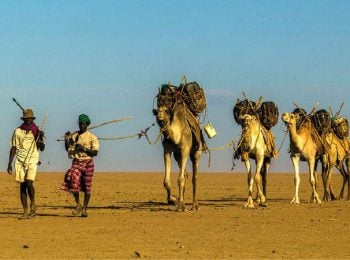Day 1 - Nairobi
Arrive in Nairobi. The rest of the day is at leisure. Overnight Emory Hotel or similar.
Day 2 - Samburu National Reserve
Day 3 - Samburu – Ngurunit
Drive to Ngurunit, located at the base of the Ndoto Mountains where we explore the lands of the Samburu and Rendille people, two of Kenya’s most striking ethnic groups. We visit their settlements and learn about their way of life in this harsh corner of the country. Overnight Camp Ndotto or similar. (BLD)
Day 6 - Loyangalani
Drive across some of East Africa’s most dramatic scenery to Loyangalani. The frontier town is a melting pot of ethnic groups, and divides neatly into tribal zones; the Samburu, Turkana and Rendille have each made one part of the town their home. Overnight Oasis Hotel or similar. (BLD)
Days 7-8 - Loyangalani
We spend the next two days exploring this fascinating landscape, meeting the Turkana and El Molo people. On Day 7 we sail to Roto Island, a sacred place for the El Molo, and visit the Desert Museum. Day 8 is spent visiting the Marti rock art site and visiting a Turkana fishing village. Overnight Oasis Hotel or similar. (BLD)
Day 10 - Maralal
This morning, we have a long drive towards Maralal, the capital of the Samburu county. Upon arrival, we have a walk around the city to get a sense of local life here. Overnight Samburu Guest House or similar. (BLD)
Day 11 - Churo
Head to the highlands, inhabited by the Pokot community. The Pokot people are mainly pastoralists and are distinguished by their giant beaded necklaces. We explore the village, learning about the daily lives of the villages and seeing some of the unique traditions found here. Overnight camping. (BLD)
Day 12 - Lake Baringo
We leave the village behind and make our way to Lake Baringo, one of the Kenyan Rift Valley lakes. The lake is home to a number of species, including crocodiles and hippos and we enjoy a boat excursion in the hopes of spotting these. Overnight Tumbili Cliff Hotel or similar. (BLD)
Day 13 - Baringo – Nairobi
Return to Nairobi and transfer to the airport for departure. (BD)
Please note: You will not arrive back into Nairobi until late afternoon and so should not book any flights until the evening.
What's included?
What's not included?
Visas
Most travellers will require a visa to enter Kenya, which can no longer be obtained on arrival and must be applied for as an e-visa via the following website:
You will need to have six months validity left on your passport and have two blank pages.
Visa regulations can change though, so we recommend that you check the situation again two months before travel.
Health and vaccinations
We are not medically qualified and so we recommend that you speak to your doctor or nearest health professional for advice concerning recommended vaccinations. For more advice on vaccinations, you can also visit www.fitfortravel.nhs.uk.
If you have any physical limitations that might impact your ability to participate in the planned tour activities, it’s essential that you make us aware as soon as possible so that we can discuss this with you.
Insurance
It is a condition of joining our tours that you have suitable travel insurance in place, and we cannot accept travellers without insurance. All policies differ in terms of what they will cover, but as a minimum you need medical and health cover, which will cover you for the whole time that you are away. Most policies will also include cancellation cover, which will cover you if an unforeseen circumstance obliges you to cancel your trip. We recommend that you obtain your insurance as soon as you book your trip.
Please note that government travel warnings often affect the validity of your travel insurance, and you should check this with your insurance company.
Money
The local currency in Kenya is the Kenyan shilling. The only real place to change money on this trip is Nairobi, and your guide can assist with this.
Travel advice
We keep a very close eye on the travel advice issued by the UK Foreign and Commonwealth Office so that we can keep you up to date with any warnings. At the time of writing the FCO does not advise against travel to the parts of Kenya that we visit on this trip.
This relates to advice from the British government – other nationalities need to check the stance of their own governments.
Please note that the information contained above is highly susceptible to change, and while we endeavour to keep up to date we recommend that you use this as a guide only. Should you have any questions, please don’t hesitate to contact us.













